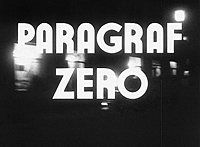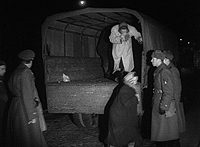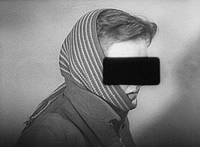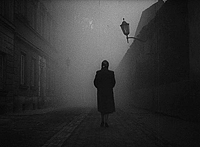 Paragraf zero
Paragraf zero
Poland, 1957, black and white, 16 mins
It says something for the social stigma associated with prostitution that this is apparently the only documentary of the ‘black series’ to tackle it. Very different in tone from Włodzimierz Borowik’s rural Rocky Soil (Skalna ziemia, 1956), this is set in a far more enclosed series of urban spaces: dimly-lit streets, squalid flats, interrogation cells. As with such films as Warsaw ’56/Warszawa 1956 and The Lublin Old Town/Lubelska starówka (both 1956), the film begins by showing Warsaw as we would like to imagine it: populous and civilised, well-lit and regulated, even at night. But the narrator invites us to take a closer look at a particular coffee house – when a man approaches two young women sitting on their own, is it a straightforward chat-up situation or the prelude to a more businesslike arrangement?

At 11pm, the crowds have mostly gone home, leaving only a few lone women on street corners. We jump to the obvious conclusion, but the narrator admonishes us: “Prostitution does not exist in our country, our legislation has successfully eliminated it”. He goes on to explain that it’s precisely because of this official line that it’s impossible to come up with workable remedies: the state has no business enquiring after the health of a woman, even though her profession is obviously a risky one (and not just her sexual health: screams from a patch of derelict ground betray other dangers). It’s only when a non-prostitution-related crime such as assault or murder is committed that the militia is legally allowed to take action. They know perfectly well where the various assignations are conducted, but most of them are behind closed doors: they only have access to public spaces.
Antoni Staśkiewicz’s high-contrast cinematography relies, Weegee-like, on suddenly shining a spotlight onto the subject and watching them react – sometimes they hide their faces, at others they scuttle away, but they usually reveal something about themselves, whether it’s a group of empty bottles on the floor, discarded underwear, a bed made up of rags and old newspapers. Many of the prostitutes wear headscarves, which seems as much a means of preserving one’s anonymity as from protection against the elements (the street prostitutes are well beyond making any kind of fashion statement). There’s something uncomfortably voyeuristic about this approach, but it certainly reinforces Borowik’s overall message: if prostitution doesn’t exist, how come we’re getting material like this?

The film’s second half takes place in one of the buildings run by the Citizen’s Militia, its staff having to deal with a bevy of drunken prostitutes (and their pimps) on a nightly basis. Shooting from a concealed vantage point, the camera films the confrontations between the militia men and the women, who are often angry enough to trigger sporadic outbreaks of violence, though these are swiftly brought under control. The heart of the film lies in the subsequent interrogation scene in which a variety of women – their eyes obscured by a jittery black rectangle (virtually all the footage in the film features genuine prostitutes) – are asked their ages and social circumstances.
The first is just sixteen and hasn’t even finished school, and her mother (also present) wants her put in an institution – though the narrator tempers the bleakness by pointing out that sixteen isn’t too late to repair the damage. The second is older (twenty-three), more confident, and claims to be happy with her existence, though the narrator wonders whether this will still be the case a few years later. The third is older still, and works as a prostitute because her fiancé is in prison. When she claims she makes virtually no money from prostitution and that it’s cold and uncomfortable, the interrogator asks why she does it, and is told that she was forced into it by a friend who got her drunk on vodka. The fourth is middle-aged, and has been a prostitute since 1939 after leaving an unspecified institution – in one of the film’s rare moments of black comedy, she says that a friend of hers from that period is now a nun. The narrator predicts that this is how the younger prostitutes will end up, wandering among the ruins of Warsaw looking for clients.

Contrary to what was probably the popular view, the interrogators themselves are women, their questions and their demeanour suggesting that they’re not unsympathetic to the plight of their charges. But as the narrator points out, while some can certainly be saved, others can only be treated – but both remedies require legislation that admits to the existence of the problem in the first place (the film’s title refers to the absence of any such article in the Polish penal code). As with Jerzy Hoffman and Edward Skórzewski’s equally hard-hitting The Children Accuse (Dzieci oskarżają, 1956), the film’s final shots of cold, shivering women trying to get comfortable on a bare cell floor before being expelled en masse tell their own story and point an equally accusing finger at the system that permits it. The final shot, of a woman walking down an otherwise empty street into encroaching fog, would be eerily beautiful if divorced from the rest of the film, but instead it’s intensely unsettling – especially as an overlaid title confirms that every shot in the film aside from the coffee-house opening depicted actual situations.
- Director: Włodzimierz Borowik
- Camera: Antoni Staśkiewicz
- Editor: Maria Orlowska
- Sound: Bohdan Kajan
- Music Editor: Stefan Zawarski
- Text: Jerzy Bossak (as Jerzy Szelubski)
- Narrator: Tadeusz Łomnicki
- Production Manager: Andrzej Liwnicz
- Production Company: WFD
The film is included on PWA’s Polish School of the Documentary: The Black Series double-DVD set (Region 0 PAL). The source print is generally in very good condition, bar the odd faint tramline and a brief splice at approx. 3:10: it’s probably safe to assume that the high-contrast images with their looming, noirish shadows are presented as intended, especially as the lighting in the second half is much softer. There’s a modicum of hiss underpinning the soundtrack, but this is easy enough to tune out. The subtitles have a few typos (“Militia uses gentle persuation”), but I never felt short-changed by the translation. The mid-point scene where the prostitutes argue with the militiamen is left unsubtitled, presumably because everyone’s yelling at once – but a translation is hardly necessary.